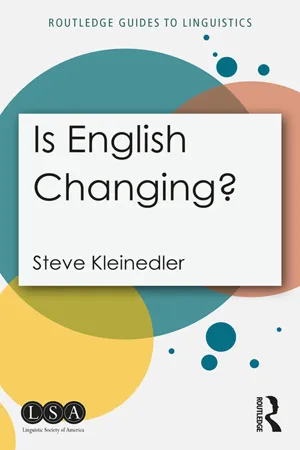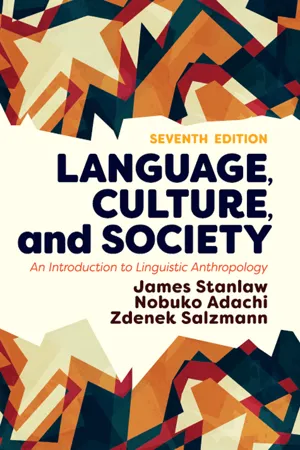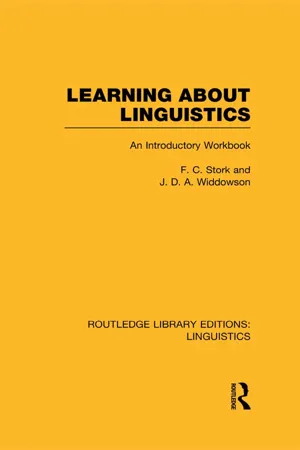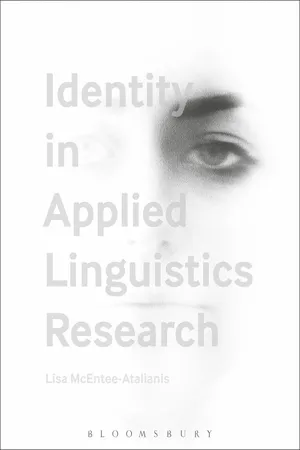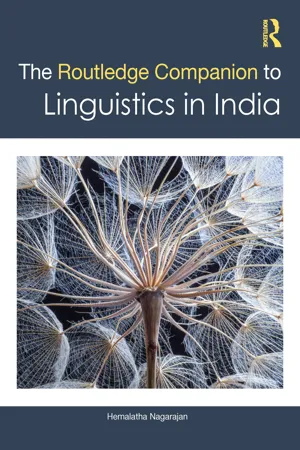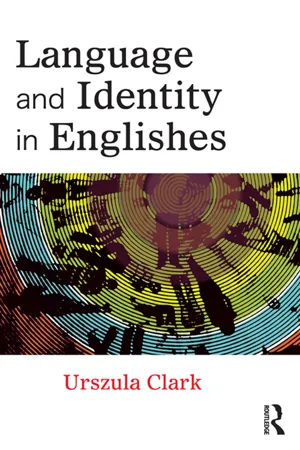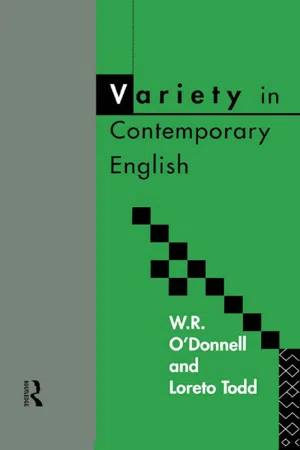Languages & Linguistics
Sociolect vs Idiolect
Sociolect refers to the language variety associated with a particular social group, such as a community, region, or social class. Idiolect, on the other hand, pertains to an individual's unique linguistic style and usage. While sociolect reflects the shared linguistic features of a group, idiolect encompasses the distinct language patterns and expressions of an individual.
Written by Perlego with AI-assistance
Related key terms
10 Key excerpts on "Sociolect vs Idiolect"
- eBook - ePub
- Steve Kleinedler(Author)
- 2018(Publication Date)
- Routledge(Publisher)
Society and culture
Each of the previous chapters was an overview of a linguistic subfield and examined how English has changed in that subfield.7.0 IntroductionThis chapter deals with SOCIOLINGUISTICS , the study of the influence of society and culture on language, including the way society and culture cause language change. Sociolinguists analyze the phonological, morphological, syntactic, semantic, or pragmatic features of one or more social groups (such as ones categorized by gender, economic class, race, ethnicity, or age). Some sociolinguists document how these linguistic features are manifested in the speech of a particular social group, others compare and contrast similarities and differences across multiple groups, still others document linguistic changes that certain groups innovate.Obviously, no social or cultural group is a monolithic entity. The phonological features of the working class in Pittsburgh are different from those of the working class in Manchester, Baltimore, or Adelaide, and these phonological features change over time.REGIONAL VARIATION (also called DIALECTOLOGY ) is the study of how a language varies from region to region. For languages spoken worldwide like English, the analysis can be global or within a country: for example, documenting a variety of English spoken in the bayous of Louisiana, or comparing English spoken in southwestern England to that of Yorkshire.7.1 Language and varietyImagine two people speaking to each other. Could you tell if they’re speaking the same language, different dialects of the same language, or different languages? Let’s examine what this question means. - eBook - ePub
Language, Culture, and Society
An Introduction to Linguistic Anthropology
- James Stanlaw, Nobuko Adachi, Zdenek Salzmann(Authors)
- 2018(Publication Date)
- Routledge(Publisher)
idiolect. Almost all speakers make use of several idiolects, depending on the circumstances of communication. For example, when family members talk to each other, their speech habits typically differ from those any one of them would use in, say, an interview with a prospective employer. The concept of idiolect therefore refers to a very specific phenomenon—the speech variety used by a particular individual.DIALECTSOften, people who live in the same geographic area, have similar occupations, or have the same education or economic status speak relatively similar idiolects compared to those from other groups. These shared characteristics may entail similarities in vocabulary, pronunciation, or grammatical features. When all the idiolects of a group of speakers have enough in common to appear at least superficially alike, we say they belong to the same dialect. The term dialect, then, is an abstraction: It refers to a form of language or speech used by members of a regional, ethnic, or social group. Dialects that are mutually intelligible belong to the same language. All languages spoken by more than one small homogeneous community are found to consist of two or more dialects.Mutual intelligibility, of course, can vary in degree. In the early 1950s, a number of men and women from eight reservations in New York and Ontario were tested in an experiment designed to determine which of their local dialects were mutually intelligible and therefore dialects of one language, and which were not and therefore could be classified as individual languages of the Iroquoian language family. Even though the investigators arrived at percentages of intelligibility between any two of the Iroquoian speech communities, the question of where the boundaries lay between intelligibility and unintelligibility remained unresolved. If the boundaries between language and dialect had been drawn at 25 percent of mutual intelligibility, there would have been four different languages, of which one would have consisted of two dialects and another of three. If set at 75 percent, there would have been five languages, two of which would have consisted of two dialects each. - eBook - ePub
- F.C. Stork, J.D.A. Widdowson(Authors)
- 2014(Publication Date)
- Routledge(Publisher)
IDIOLECT . We all have different idiolects in the same way that we all have different fingerprints and such idiolectal features are sometimes used for the purpose of ascertaining authorship of texts. The concept of idio lect is the ultimate division in language variety, since dialects are really made up of a group of idiolects which have enough in common to warrant their being placed in the same group, but less in common with a different group of idiolects.So far in our discussion of regional and social varieties of English, we have been talking about the English used in England. We must remember, however, that there are many other varieties of English used throughout the world, as well as in the British Isles. Within these islands we have Scots, Welsh and Irish English which differ from the regional varieties of English within England and are not normally judged on the same social scale. They can, however, be placed on a scale of their own in terms of their acceptability for English speakers of English: Scots is on the whole thought more prestigious than the Irish and Welsh varieties of English. Outside the British Isles such scales of prestige carry little significance, and English is unique among the languages of the world in that it is the official language of many different cultures and nations and the second language of practically the rest of the world. There are of course, fundamental differences between the English of England and that of such areas as the United States, Canada, Australia, New Zealand, South Africa, India etc., but what is in many ways more surprising is that in spite of the wide divergence of culture and political and social backgrounds we can identify a kind of English which is readily understood in all the English speaking areas. Some linguists use the term GENERAL ENGLISH to refer to this type of language. It is a sobering thought for many speakers of British English that they constitute a minority of the English speaking world, and that speakers of RP - eBook - ePub
- Gerard Van Herk(Author)
- 2012(Publication Date)
- Wiley-Blackwell(Publisher)
2 Language and SocietyIn this chapter:- Defining “language” in sociolinguistics
- Language vs. dialect
- Dialect, slang, accent, variety
- Social organization and language
- Doing variationist sociolinguistics
Years ago, my family was walking the narrow roads of Thorpe, a village in northern England, and a car nearly clipped us. We joked that that would be one way to lose weight. Ever since, we’ve referred to cars passing too close to us as the “Thorpe Diet.” Nobody else knows what we’re talking about, of course.You may also have “inside jokes” like this, turns of phrase or odd meanings for words that only make sense to close friends or family, people who have shared particular experiences with you. This is kind of how sociolinguists think about language use – within any group, shared experiences or understandings of the world lead us to use language in a particular way, and to define or reinforce our place in the group by drawing on those possible ways of using language.In chapter 1, I proposed that we define sociolinguistics as the study of the relationship between language and society. In this chapter, I’d like to expand on that by looking at how sociolinguists define “language” and “society.” As you’ll see, doing that will bring back another definition from the first chapter – “It depends on who you ask.” Or, better yet, “It depends on what you want to find out.”Defining “language” in sociolinguisticsWhen sociolinguists talk about “language,” we mean language as it is actually used. That doesn’t sound very profound, but it actually sets us apart from both normal people and some other branches of linguistics.Sociolinguists vs. other linguistsIf you work in mainstream (“theoretical”) linguistics, you may take issue with the previous sentence, with its implication that other linguists don’t necessarily look at language as it’s actually used. You may say, “Wait a minute. Theoretical linguists look at real language all the time. We do fieldwork, learning from native speakers of a language.” Fair enough. What I’m really talking about here is the object of study, the actual data that each discipline uses to build theoretical claims. - eBook - ePub
- Lisa McEntee-Atalianis(Author)
- 2018(Publication Date)
- Bloomsbury Academic(Publisher)
CHAPTER TWO Linguistic IdiosyncrasyIntroductionAll talk displays its speaker’s individual voice. This is necessary because self-expression is necessary: no matter how much a society may value conformity or define people in relationship to others, individuals must on some level express individuated selves.In order to do this, speakers must do things with language that other speakers do not do. Each speaker must, quite literally, be idiosyncratic.BARBARA JOHNSTONE (1996: 187)An enduring debate in sociolinguistics is the relationship between the individual and society. Scholars have questioned how individual patterns of language use relate to community-wide ideologies, language practice and change, with recent studies increasingly attempting to account for the fluidity and variability of language use within and across individuals as aspects of personal and social identity are signalled.The development of variationist sociolinguistics and linguistic anthropology in the 1960s and 1970s, most notably through the quantitative urban dialectological research of William Labov and the development of an approach known as ‘ethnography of speaking’ by anthropologists Dell Hymes and John Gumperz, made variation in linguistic performance within speech communities an important object of study. Since the early identification of stratified patterns of language use in social groups on the east coast of the United States (Labov) and language variation in the multilingual nations of India and Norway (Gumperz and Hymes), variationist research has developed significantly and with it interest in idiosyncratic language use and identity.In this chapter, we focus on selective studies that have taken the individual and idiosyncratic language use as their primary object of study. We begin with a review of the historical treatment of identity within traditional variationist sociolinguistics and end with a consideration and description of selective contemporary studies of individual variation and style which adopt a phenomenological approach with nuanced analytical specificity. We begin with the work of Le Page and Tabouret-Keller (1985), who in their investigation of postcolonial multilingual communities took idiosyncratic language use as their analytic foci in an investigation of variation, observing how a community or social group is constructed through individual linguistic ‘acts of identity’. We next consider how linguistic personae accrete (Rauniomaa 2003) via the particularities of individual language style and stance drawing on the concepts of individual ‘voice’ and ‘lingual biographies’ (Johnstone 1996). We finally review concepts such as language repertoires, rational choice/strategy and extend our discussion of style, focusing on more recent work which draws on the models of indexicality and enregisterment. First, however, we situate our discussion within the field of variationist sociolinguistics. - eBook - ePub
- Rob Penhallurick(Author)
- 2018(Publication Date)
- Bloomsbury Academic(Publisher)
Both disciplines investigated the variation of speech in relation to locale. In other words, both were interested in regional dialects. However, in the early years of sociolinguistics there was no production of large-scale dictionaries and atlases. Rather the focus was on the phonology and (to a lesser degree) the grammar of individual urban localities, particularly the statistical correlation of phonological variation with the age, class, ethnicity, and sex of speakers. Sociolinguistics concentrated on social variation in particular locations. From the outset, sociolinguistics also had a broader scope than dialectology, and is concerned with a range of topics, such as language and gender, pidgin and creole varieties of language, bilingualism and multilingualism, and language planning and educational policy. It connects with other sub-disciplines of modern linguistics, such as pragmatics (the study of language in use generally) and discourse analysis (the study of extended stretches of language), and from the beginning there were strands of sociolinguistics that were more allied with anthropology and with sociology than was the type of sociolinguistics pioneered by Labov in 1966. It is this Labovian strand that is most relevant to dialect study and therefore to the present book. It is referred to by an assortment of names in the literature, with social dialectology, urban dialectology, variationist sociolinguistics or variationist theory or variationism, and Labovian sociolinguistics among the most prominent. For good reasons, early dialectology had been mainly interested in the older, traditional regional dialects - eBook - ePub
- Hemalatha Nagarajan(Author)
- 2022(Publication Date)
- Routledge India(Publisher)
SociolinguisticsDOI: 10.4324/9781003099024-7What is your good name, please? I am remembering we used to be neighbours.R. Parthasarathi (1998)Module 1: Language and Society and Language Varieties
Language is not spoken in a vacuum. Apart from individuals who convey their thoughts, ideas, and feelings through the medium of language, language also forms an integral aspect of any society or culture, governed by its norms and practices. The branch of linguistics that deals with how language is used in a society or culture and is governed by factors like gender, race, class, caste, etc., is called sociolinguistics.The English anthropologist Sir Edward Burnett Tylor defined culture as something that is “acquired by man as a member of society” and language too forms an integral part of it as much as the food we eat; the types of clothes we wear; or the traditions, festivals, and practices we follow. We all need food to survive, a roof over our head, and clothes to protect us from ravages of weather. However, the type of food we consume, the type of houses we live in, and the kinds of clothes we wear are dictated by our culture. Likewise, there are a number of aspects of language that are universal. However, in this chapter, we explore those aspects of language which are conditioned by culture, region, class, caste, and other aspects of society.Language Varieties
Any important aspect of social structure and function is likely to have a distinctive linguistic counterpart. People belong to different social classes, perform different social roles, and carry on different occupations (David Crystal 1995 : 3)One’s language can be conditioned by certain static factors and by some dynamic factors. The static factors are aspects like region, class, caste, gender, etc., of the speaker, which remain unaltered in all circumstances.1 There are also some dynamic factors that condition our language use. These are factors like the subject matter, the medium of communication (spoken or written, e-mail, or text message), and the addressor–addressee relationship, fashions in language use, etc. The static factors mostly lead to dialects, and the dynamic factors contribute to differences in registers - eBook - ePub
- Rebecca Pozzi, Tracy Quan, Chelsea Escalante, Rebecca Pozzi, Tracy Quan, Chelsea Escalante(Authors)
- 2021(Publication Date)
- Routledge(Publisher)
Scholars concluded that learners need to do more than follow native syntax rules or use appropriate vocabulary; language must also fit the social and interactional setting. That is, sociolinguistic competence encompasses the abilities that allow speakers to interact in situationally appropriate ways. Sociolinguistic competence, then, describes language users’ ability to reflect speaker identity, to vary language patterns in response to different contexts of interaction, and to acquire and interpret geographic norms of interaction. Sociolinguistic variation, or the variable patterns of use that occur across speakers or contexts of interaction, is an important aspect of sociolinguistic competence and is a tool for measuring language acquisition. Sociolinguistic variation provides a framework for examining differences in patterns of language use related to speaker characteristics, listener characteristics, conversation topics, and interactional contexts. Generally, variationist sociolinguists study language by calculating the frequency of a particular form or set of forms and identifying linguistic and social factors that predict usage patterns. For example, a sociolinguist might examine how frequently speakers use overt and null subjects (e.g., yo hablo vs. hablo for “I speak”) and the factors that contribute to that use (e.g., comparing first- and third-person contexts to predict different rates of overt pronoun occurrence). Because sociolinguistic variation is one important component of sociolinguistic competence, variationist research has led the way in investigating the development of sociolinguistic competence across speaker populations and learning contexts - eBook - ePub
- Urszula Clark(Author)
- 2013(Publication Date)
- Routledge(Publisher)
Chapter 1 , the cultural theorist Mikhail Bakhtin was concerned particularly with the relationship between language and history, offering new and radical concepts and ways of understanding the social functions of language. He writes:At any given moment in its evolution, language is stratified not only into linguistic dialects in the strictest sense of the word, according to formal linguistic markers, especially phonetic, but also – and this is the essential point – into languages that are socio-ideological: languages of social groups, ‘professional’ and ‘generic’ languages, languages of generations and so forth.(1981: 259)What Bakhtin is arguing here has been a central theme of this book, namely that how we use language is determined as much by social, cultural, historical and ideological concepts within which it functions as by its physical manifestations of phonetics, lexis and morphosyntax.Historical and Sociopolitical Contexts of EnglishesChapters 2 and 3 have given an overview of a sociolinguistic history of English, to explain the reasons why we have so many different varieties of Englishes in the world today. They have also shown how ‘English’ has come to have so many varieties both within English-speaking countries and around the world, to account for how variational uses of different Englishes are viewed or perceived within and across the wider national and increasingly global contexts, as well as within local communities within which they are situated. As such, they provide an overview of the wider historical and sociopolitical contexts within which language happens, which includes consideration of the sets of beliefs, values and assumptions that underpin them.By and large, these chapters show that the factors affecting linguistic change are politically and economically driven. Historical and contemporary factors such as invasion, colonisation and the demands of social order based upon law, education, economics and politics intertwine, at any moment in time, with the linguistic and communicative practices of the social groups most affected. Depending upon the prevalent social order, different groups will be affected in different ways. Had Germany won the Second World War, for example, the world language in use today might have been German; had Harold IIin 1066 won the Battle of Hastings on the south coast of what is now England and conquered the Normans arriving from the north coast of what is now France, it could have been French; in the future, some predict the world language could be Chinese. The geographic atlas of the world is in a constant and perpetual state of flux, with boundaries being redrawn in response to political events. The dissolution of the USSR from the 1980s onwards has seen that part of the world redefined into separate states, just as atlases from the 1930s and 1940s show the extent of British, French and Dutch colonisation of countries that have since gained independence. Such an approach interrelates and integrates aspects of descriptive linguistics with sociolinguistics and discourse analysis. - eBook - ePub
- W.R. O'Donnell, LORETO Todd(Authors)
- 2013(Publication Date)
- Routledge(Publisher)
Grammatical idiolectal differences are a bit more difficult to pin down. Nevertheless, they do occur. For example, one finds individuals who favour ‘-wise’ as an adverbforming suffix, as in ‘salary-wise’, ‘holiday-wise’, ‘work-wise’. And the reader may well note in the work of some writers a characteristic fondness for ‘moreovei’, ‘furthermore’ and ‘however’ as introductory sentence adverbs. It is possible to observe, also, individual differences in such things as the use of relative pronouns (as between ‘the man who I saw’, ‘the man whom I saw’ and ‘the man I saw’); in a fondness for subordination in preference to co-ordination; the use of a noun instead of a clause with a similar meaning (‘his behaviour’ rather than ‘the way he behaves’); and, in fact, wherever there are alternative possibilities some will favour one, some another.We may note in passing that the idiolect is itself subject to internal variation with time. We all add new items to our vocabulary from time to time and let others go out of use; we modify our pronunciation in response to non-linguistic influences such as change of residence or of status; and our individual grammar acquires new constructions and relinquishes old ones. (See also under ‘Style’, Chapter 4, for another kind of idiolectal variety.) The characteristic of human languages even at the level of the idiolect, therefore, is constant diversity.Regional diversity takes over from individual diversity. The two are not different in essence, but in degree. Each of us is, in a real sense, in contact with every other speaker of our language. With some, relatively few, we are in regular direct contact; with others, again, we are in contact irregularly and/ or indirectly, through intermediary contacts of various kinds; and, of course, we only contact the great majority through a whole complex of intermediate individuals and groups. Through this complex of intermediary contacts, small differences between individuals in close regular contact grow and extend until they may become large enough to render two people who claim to speak the same language mutually incomprehensible; as, say, a Kentucky hillbilly and a Scottish crofter. Regional diversity, thus, multiplies individual diversity.
Index pages curate the most relevant extracts from our library of academic textbooks. They’ve been created using an in-house natural language model (NLM), each adding context and meaning to key research topics.
